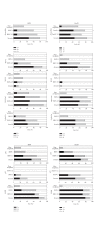Histological Characterization of Biliary Intraepithelial Neoplasia with respect to Pancreatic Intraepithelial Neoplasia
- PMID: 24860672
- PMCID: PMC4003763
- DOI: 10.1155/2014/678260
Histological Characterization of Biliary Intraepithelial Neoplasia with respect to Pancreatic Intraepithelial Neoplasia
Abstract
Biliary intraepithelial neoplasia (BilIN) is a precursor lesion of hilar/perihilar and extrahepatic cholangiocarcinoma. BilIN represents the process of multistep cholangiocarcinogenesis and is the biliary counterpart of pancreatic intraepithelial neoplasia (PanIN). This study was performed to clarify the histological characteristics of BilIN in relation to PanIN. Using paraffin-embedded tissue sections of surgically resected specimens of cholangiocarcinoma associated with BilIN and pancreatic ductal adenocarcinoma associated with PanIN, immunohistochemical staining was performed using primary antibodies against MUC1, MUC2, MUC5AC, cyclin D1, p21, p53, and S100P. For mucin staining, Alcian blue pH 2.5 was used. Most of the molecules examined here showed similar expression patterns in BilIN and PanIN, in which their expression tended to increase along with the increase in atypia of the epithelial lesions. Significant differences were observed in the increase in mucin production and the expression of S100P in PanIN-1 and the expression of p53 in PanIN-3, when compared with those in BilIN of a corresponding grade. These results suggest that cholangiocarcinoma and pancreatic ductal adenocarcinoma share, at least in part, a common carcinogenic process and further confirm that BilIN can be regarded as the biliary counterpart of PanIN.
Figures



References
-
- Zen Y, Adsay NV, Bardadin K, et al. Biliary intraepithelial neoplasia: an international interobserver agreement study and proposal for diagnostic criteria. Modern Pathology. 2007;20(6):701–709. - PubMed
-
- Albores-Saavedra J, Adsay NV, Crawford JM, et al. Carcinoma of the gallbladder and extrahepatic bile ducts. In: Bosman FT, Carneiro F, Hruban RH, Theise ND, editors. WHO Classification of Tumors of the Digestive System. 4th edition. Lyon, France: IARC, World Health Organization of Tumors; 2010. pp. 266–273.
-
- Zen Y, Sasaki M, Fujii T, et al. Different expression patterns of mucin core proteins and cytokeratins during intrahepatic cholangiocarcinogenesis from biliary intraepithelial neoplasia and intraductal papillary neoplasm of the bile duct—an immunohistochemical study of 110 cases of hepatolithiasis. Journal of Hepatology. 2006;44(2):350–358. - PubMed
-
- Nakanishi Y, Zen Y, Kondo S, Itoh T, Itatsu K, Nakanuma Y. Expression of cell cycle-related molecules in biliary premalignant lesions: biliary intraepithelial neoplasia and biliary intraductal papillary neoplasm. Human Pathology. 2008;39(8):1153–1161. - PubMed
LinkOut - more resources
Full Text Sources
Other Literature Sources
Research Materials
Miscellaneous

